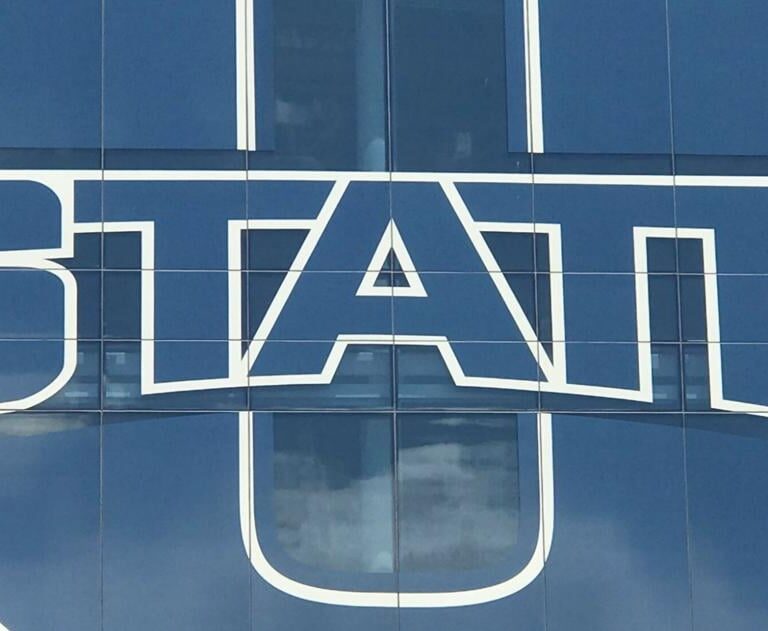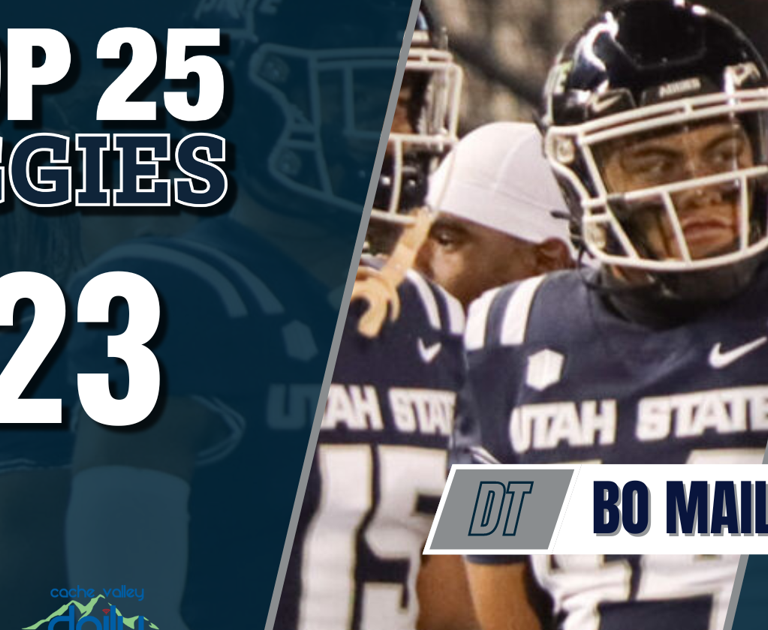Utah State running back Rahsul Faison carries the ball in the Aggies’ 78-28 win over Idaho State on Sept. 9, 2023
Utah State needed a response on Saturday against Idaho State. A response to the loss against Iowa in Week 1. A response to the loss against Weber State last year. A response to the doubts about how this team could be successful with so many new faces under the helmets and on the coaching staff.
The response the Aggies provided was the biggest scoring output in more than 100 years and a 50-point win.
Not bad.
A note on the quality of competition certainly needs to be made but, when on the same week that Fresno State barely edged Eastern Washington 34-31 in overtime and Nevada lost 33-6 to Idaho — both FCS teams — and last week San Diego State beat these same Bengals by only eight points, the fact Utah State took care of business in such dominant fashion shouldn’t be overlooked.
What made this domination possible was a combination of Utah State’s playmakers, old and new, with a great coaching performance. Starting with the coaching, one could say this game was won in the week of practice leading up because every coach was surely in every player’s ear about how the Aggies lost to Weber State a year ago. The coaches were also working the players hard over the numerous mistakes made in the loss to Iowa. The players responded to that coaching well and it produced one of the best efforts in a game we’ve seen out of the Aggies in a while.
“Really proud of how the guys responded over the course of last week,” Anderson said. “We wanted to grow up from Iowa to Idaho State. We respected the opponent, saw what they did to San Diego State and just assumed we were going to get 60 minutes of their best. You talk about it all week, you prepare for it. I thought the guys were very mature in the process and preparation for it. We had good practices and the energy level was phenomenal coming out. That’s one of the best things that shows up on tape is just how hard we played in all three phases.”
To explore what kept this game from another embarrassing loss or close FCS win and turned it into an all-time blowout, I’m going to run through just a handful of the Aggies’ many great plays on offense throughout the day. We’d be here a while if a breakdown of all of USU’s big-time plays on both sides of the ball so let’s stick with five on this occasion.
Starting with the run game since it’s one of the best examples of the “coaches coach and players play” theme here. It begins with Utah State, much like any other team, searching out numbers advantages on run plays (teams also clearly look for those same advantages in the pass game, but I’m sticking with rushing for the moment).
“You’re always looking for an advantage whether it be the throw game or run game; where are your numbers, leverage points,” Anderson said. “In their particular case because of what they choose to do with that Spoke defense you know they’re going to be adding numbers to the box late. We felt like we could get bodies on them. I thought (offensive line coach Cooper Bassett) did a great job of designing a run game that really fit our people and attacked what they were doing defensively.”
You can see the math play out in the most basic way on this down which was one of Rahsul Faison’s several long runs of the day. Here the Aggies are facing a five-man box with six blockers (seven if you’re counting Vaughn who’s lining up just outside of Broc Lane). It’s almost comically predictable what happens next. All Faison had to do was make one man miss he’s off to the races with only the sideline saving a touchdown.
The defense isn’t always going to hand you a numbers advantage in the box. On Briggs’ 58-yard touchdown run on the Aggies’ first drive of the game, Idaho State matches Utah State’s six blockers with six players in the box with multiple safeties available as backstops. But a little more good play design gets USU where it wants to be in terms of numbers. First the three receivers to the right send all of ISU’s corners to one side, leaving all outside contain duties on the weak side to the defensive end and linebacker. Second, a zone read look allows USU to simply not block the backside defensive end. This shifts Utah State’s six blockers onto the five remaining players in the box and the safety. Some stellar blocking (i.e. Ralph Frias sealing a defensive end line up outside of him AND chipping the backside linebacker) and breakaway speed then create the resulting big-time run. It’s such a clear win on the play that Falepule Alo is celebrating the touchdown before Briggs crosses the 50-yard line.
Another great way Utah State created a numbers advantage, which they’ve done plenty of times in the past, was to create a five-man box with a spread-out formation but then call a QB draw. The running back becomes a surprise blocker and on this play Booth throws a key block on a linebacker for what became a nine-yard designed run for Cooper Legas.
Funnily enough, on the very next play, when USU did a hurry-up play with a five-wide set, it created a four-man box and Legas just ran it again for another nine yards.
I’ve glossed over the contributions of the running backs in these plays a bit so let’s give them some flowers here. Briggs, Booth and Faison were amazing in how much they made defenders miss tackles. The Idaho State trainers probably ran out of ice and tape to heal up the broken ankles the Aggie running backs kept producing. The play design and good blocking created solid runs at minimum, like four or five yards. USU’s backs turned those four or five yard gains and transformed them into 40 and 50 yard gains by being outstanding in their own right. And when the running backs broke open runs, the wide receivers blocked downfield to add extra yards on top of things.
“Great respect for how our guys played out in space,” Anderson said. “We made guys miss. We blocked at the second and third levels. Our receivers blocked their tails off downfield. O-linemen pulling, blocking downfield. It was a really a group effort.”
Let’s move on and look some of my favorite route combinations from Saturday, mainly these two zone-busting flood concepts. Both involve Terrell Vaughn, Jalen Royals and Broc Lane lining up in a bunch on one side of the field (coincidently the left side on both occasions). The first produced one of Legas’ three separate 20-plus yard passing plays. Terrell Vaughn goes in motion prior to the snaps to begin the eventual flood of the left side of the field. Lane sticks to the flat, pulling one defensive back in and Royals clears out the defensive back over the top with his go route. Vaughn then reversed field back toward the sideline, almost sneaking into the space in Idaho State’s coverage and Legas drops a dime right into the window for a 21-yard gain.
As a side note having a tight end like Lane that can split out wide is a great benefit since it forces the defense into an uncomfortable spot personnel-wise. Lane being a legitimate threat as essentially a wide receiver helped make both of these plays work. And while a receiver in this same spot would still do the trick, the Aggies were able to run tempo offense to keep the same defensive personnel on the field, and a couple of plays later Lane was blocking for a 31-yard run by Booth.
Later the Aggies run a flood concept on 2nd & Goal from the four. Vaughn, Lane and Royals are again lined up next to each other. Royals and Lane initially show a bubble screen look with Royals running the bubble route and Lane blocking. But Lane makes a break for the middle of the field, drawing his man in and leaving Vaughn to again find a giant hole in the zone coverage and Legas easily hits him in the corner of the end zone.
All of that is just what the offense did, and it’s hardly a drop in the bucket when it came to big plays that numerous players made.
Of course, a few questions arise once one is done throwing flowers to the coaches and players for the 78-point performance. Mainly, if they’re all so smart and good, where was all this against Iowa? Well, for one, the lack of healthy tight ends really impacted the ability of Utah State to create favorable matchups in the box. The Aggies ran less than 15 percent of their offensive snaps against Iowa with a tight end in the formation. Against Idaho State, that percentage went up to more than 81 percent. Utah State did what it could with what it had against Iowa (they went with the QB draw several times to give themselves a numbers advantage and it saw some success, including a fourth-down conversion and several quality rush attempts). And when it did move to its 11 personnel with a tight end, the team immediately broke off two 15-plus yard runs.
The other, more obvious answer is the strength of opponent was obviously different and more capable last week. There’s a wide, cavernous gap between Iowa and Idaho State, with all due respect to the Bengals’ football program. Utah State is not going to have its way in run blocking the way it did Saturday when it faces Air Force, or San Diego State, or Boise State in the same way it ate Idaho State’s defensive front alive and juked its secondary most of the game.
“The one-on-one matchups were definitely more in our favor than they were in Week 1. That’ll obviously level back out this week,” Anderson said.
So this week begins the stretch of games where we find out exactly who Utah State is. How much of what it did against Idaho State can transfer over to matchups with Air Force, James Madison and UConn? Or will the Aggies go back to being the team that shows flashes but doesn’t win games like they were in Week 1 at Iowa? It’s a short week so there’s not much extra time to dwell on those questions.






